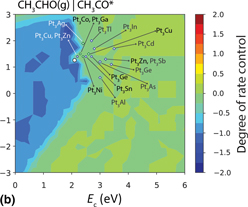Crossref Citations
This article has been cited by the following publications. This list is generated based on data provided by Crossref.
Li, Qingyuan
Wang, Yuxin
Skoptsov, George
and
Hu, Jianli
2019.
Selective Hydrogenation of Acetylene to Ethylene over Bimetallic Catalysts.
Industrial & Engineering Chemistry Research,
Vol. 58,
Issue. 45,
p.
20620.
Pasel, Joachim
Häusler, Johannes
Schmitt, Dirk
Valencia, Helen
Meledina, Maria
Mayer, Joachim
and
Peters, Ralf
2020.
Ethanol Dehydrogenation: A Reaction Path Study by Means of Temporal Analysis of Products.
Catalysts,
Vol. 10,
Issue. 10,
p.
1151.
Jalid, Fatima
Khan, Tuhin Suvra
and
Haider, M. Ali
2021.
Exploring bimetallic alloy catalysts of Co, Pd and Cu for CO2 reduction combined with ethane dehydrogenation.
Applied Energy,
Vol. 299,
Issue. ,
p.
117284.
Jalid, Fatima
Khan, Tuhin Suvra
and
Haider, M. Ali
2021.
CO2reduction and ethane dehydrogenation on transition metal catalysts: mechanistic insights, reactivity trends and rational design of bimetallic alloys.
Catalysis Science & Technology,
Vol. 11,
Issue. 1,
p.
97.
Jalid, Fatima
Haider, M. Ali
Alam, Md. Imteyaz
and
Khan, Tuhin S.
2021.
Mechanistic insights into the dominant reaction route and catalyst deactivation in biogas reforming usingab initiomicrokinetic modeling.
Catalysis Science & Technology,
Vol. 11,
Issue. 6,
p.
2130.
Jalid, Fatima
Khan, Tuhin S.
and
Haider, M. Ali
2021.
Insights into the activity and selectivity trends in non-oxidative dehydrogenation of primary and secondary alcohols over the copper catalyst.
Catalysis Today,
Vol. 370,
Issue. ,
p.
151.
Kumar, Anand
2021.
Ethanol Decomposition and Dehydrogenation for Hydrogen Production: A Review of Heterogeneous Catalysts.
Industrial & Engineering Chemistry Research,
Vol. 60,
Issue. 46,
p.
16561.
Iyer, Jayendran
Jalid, Fatima
Khan, Tuhin S.
and
Haider, M. Ali
2022.
Tracing the reactivity of single atom alloys for ethanol dehydrogenation using ab initio simulations.
Reaction Chemistry & Engineering,
Vol. 7,
Issue. 1,
p.
61.
Kumar, Amrish
Iyer, Jayendran
Jalid, Fatima
Ramteke, Manojkumar
Khan, Tuhin S.
and
Haider, M. Ali
2022.
Machine Learning Enabled Screening of Single Atom Alloys: Predicting Reactivity Trend for Ethanol Dehydrogenation.
ChemCatChem,
Vol. 14,
Issue. 2,
Yu, Ya-Xin
Wang, Gang
Zhu, Yi-An
and
Zhou, Xing-Gui
2024.
Mechanistic and microkinetic insights into the stability and activity of Ni3In catalyst for dry methane reforming.
Chemical Engineering Journal,
Vol. 479,
Issue. ,
p.
146959.
Valizadeh, Soheil
Valizadeh, Behzad
Lee, Jechan
and
Park, Young‐Kwon
2025.
Catalytic Guaiacol Hydrodeoxygenation in Supercritical Fluids: A Review.
ChemCatChem,
Vol. 17,
Issue. 5,
Pampararo, Giovanni
Garbarino, Gabriella
Traoré, Aliou Sadia
Ersen, Ovidiu
Spennati, Elena
Riani, Paola
Busca, Guido
and
Debecker, Damien P.
2025.
Nanostructured Bimetallic (Cu,Ni)/SiO2 Catalysts for the Dehydrogenation of Ethanol to Acetaldehyde.
ACS Applied Nano Materials,
Vol. 8,
Issue. 43,
p.
21113.
Dandekar, Pallavi
Ambesh, Aditya Singh
Khan, Tuhin Suvra
and
Gupta, Shelaka
2025.
Machine learning assisted approximation of descriptors (CO and OH) binding energy on Cu-based bimetallic alloys.
Physical Chemistry Chemical Physics,
Vol. 27,
Issue. 14,
p.
7151.
Farooqi, Mohammad Zakariya
and
Jalid, Fatima
2025.
Microkinetic modelling‐driven insights into water–gas shift catalysis—Towards unravelling active transition metal‐based bimetallic alloys.
The Canadian Journal of Chemical Engineering,


